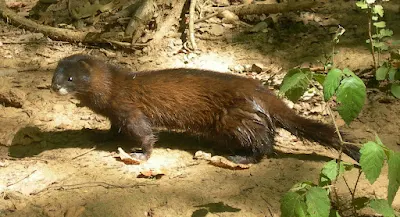20 Interesting Facts About Minks
- Minks are dark brown semiaquatic mammals native to the Northern Hemisphere. They are famous for their valuable fur.
- Minks are nocturnal and belong to the weasel family. Their closest relatives are weasels, otters, polecats, and ferrets.
- Minks and otters resemble each other, but they have visible differences. Minks are shorter (2 feet long) than otters (4 feet long), while their tails are short and bushy compared to long and slender tails in otters.
- These mammals have two extant species: American mink and European mink. The American mink is larger, more aggressive, and adaptable than their European counterparts. Their most prominent feature is the white chin.
- The native range of the American mink is North America, while the European mink is present in many parts of Europe. However, American minks are now present outside their native range due to various fur farms in Europe, Asia, and South America.
- American minks now inhabit several non-native areas in Europe and South America due to their voluntary or involuntary release from fur farms. They are invasive species in these areas and have caused the decline of European minks and other wetland animals.
- European minks were once present almost everywhere in Europe, from the Urals to northern Spain. However, their numbers and areas have reduced drastically due to human interference and the arrival of American minks. European minks have become one of the most endangered carnivores in Europe. (Source)

European minks are one of most endangered European carnivores - Minks are 12 to 20 inches long and weigh up to 2 kg. Farm minks can reach twice the size of wild minks due to better nutrition and the adoption of selective breeding techniques. Male minks are larger than females.
- Minks are generally solitary except during the mating period. Both males and females may mate with multiple individuals. Female minks can delay their general gestation period for up to two weeks. The range of the litter size is from two to eight young ones.
- Mink coats were at their peak during the 1980s. However, their popularity started to decline in the 1990s. Recently, many countries and luxury brands have banned mink fur because of the fear of vaccine-resistant COVID-19 mutation in these mammals. (Source)
- Mink oil resembles human sebum and acts as a moisturizer. Several brands use it in their cosmetic formulations to enhance the quality and complexion of human skin. (Source)
- Wild minks usually have brown-colored coats. However, selective breeding in fur farms assists them in getting a range of colors such as blue, black, white, sapphire, and pearl.
- Minks are very territorial and may fight with other minks that enter their territories. They secrete a foul-smelling liquid from anal glands to mark their territory and as a weapon against predators.
- Minks have several physical features that assist in their semi-aquatic life. They use their semi-webbed toes and waterproof oily guard hairs to swim effortlessly.
- Minks are carnivorous animals and eat small animals in their habitat. These include frogs, fish, crayfish, salamanders, voles, mice, aquatic birds, rabbits, etc. They locate prey using their sense of smell and usually store extra food in their dens.
- Minks live in burrows near a water source (streams, ponds, rivers, and ocean bays), rich in their food sources. Minks are excellent swimmers and can also climb trees.
- Minks are excellent diggers, and their burrows contain several entrances. They sometimes use burrows dug by other animals, such as muskrats.
- Minks in farms can transmit several deadly infections to humans. These include SARS and avian influenza viruses. (Source)
- Some large mammals and birds hunt minks. These include coyotes, bobcats, foxes, and great-horned owls.
- Minks can prove troublesome for farmers and homeowners due to their consumption of domestic animals and pets. They usually attack poultry (chicken and ducks), fish, rabbits, etc.



Comments
Post a Comment